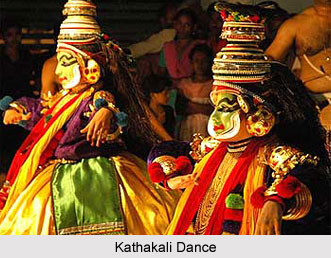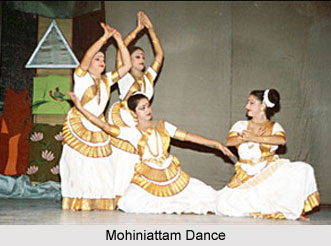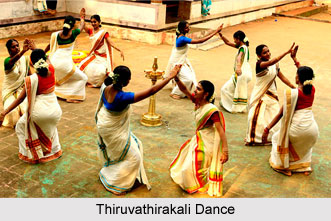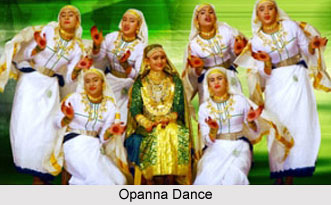 Dances of Kerala include Kathakali, Mohiniattam and Thullal. Besides these, Theyyam, Koothu, Krishnanattom and Koottiyattam are also practiced in Kerala. The traditional dance forms mainly draw inspiration from the ancient texts and epics. Hence the subjects of these performances are episodes from various legends and myths of India.
Dances of Kerala include Kathakali, Mohiniattam and Thullal. Besides these, Theyyam, Koothu, Krishnanattom and Koottiyattam are also practiced in Kerala. The traditional dance forms mainly draw inspiration from the ancient texts and epics. Hence the subjects of these performances are episodes from various legends and myths of India.
Kathakali Dance
Kathakali is one of the most well known dance forms in Kerala. It would be more appropriate to term Kathakali as dance-drama. This form of art involves flamboyance and lot of toil. This form of dance involves a unique combination ballet, pantomime, opera and masque. Kathakali dancers dance with elaborately painted faces and embellished headgears. Great significance is laid upon the make-up or `Vesham` which are essentially of five different types like Pacha, Kathi, Thadi, Kari and Minukka.
 Mohiniyattam Dance
Mohiniyattam Dance
Mohiniattam is believed to be the dance of enchantress. Superficially Mohiniattam resembles the Tamil classical dance, Bharatnatyam, but it is less complex in its mime, and, in comparison, rustically vigorous and angular. It is a very ancient dance, originally practised by women of the Nambiar caste and associated with the temples; outside the sanctuary of the 12th-century temple at Trivikramangalam there are relief carvings of sacred dancers who are found to be performing an early type of Mohiniattam. This type of dance consists of some of the characteristics of Kuchipudi, Odissi and Bharatnatyam. Mohiniyattam dance is said to explain the story of a mythological character named Mohini and the dance steps are quite graceful. The songs sung while performing this dance is generally in Malayalam and Carnatic.
Theyyam Dance
Theyyam is another important dance of Kerala. It is also known as Thirayattam. However this dance form belongs to the folk traditions. Theyyam is a performed to glorify Goddess Kali. The word literally means Goddess and is often considered to be a corrupt form of `Daivam.` There are customary dances as well, like, the Thiruathirakkali Dance. This dance takes place during marriage ceremonies. The women enact this dance while wishing a happy life to the married couples. Traditionally Thiruathirakkali Dance is part of the customs followed by the Nair families. It is performed in the month of Dhanu (December-January).
Koodiyattam Dance
Koodiyattam dance is a traditional dance of Kerala in which Sanskrit dramas are enacted skilfully. The theme is based on rituals and religions. The dancers perform Koodiyattam on a specially constructed stage termed as `Koothambalam`. This art form presents itself as an elaborate drama enacted by both men and women. Male performers hail from the Chakkiyar community, while female performers belong to the Nangiyar community. Taking place inside temples over a span of 6 to 20 days, this performance incorporates Sanskrit verses, recited with a musical background.
Velakali Dance
In Kerala, Velakali is still performed in certain temples. The dancers are dressed up as warriors and carry wooden swords and shields. It is often seen that make up and costume play an important role in the dances of Kerala. In certain dance forms, different kinds of make-up are used on the dancers depending on the characters they portray on the stage. The use of masks is also common. So whether it is Kathakali or Velakali, attires and make-up are given proper attention.
 Thiruvathirakali Dance
Thiruvathirakali Dance
Thiruvathirakali is performed by the womenfolk belonging to Hindu community. This is a beautiful group dance of Kerala and is done during festivals like the `Thiruvathira` day as well as Onam. Dancers follow a circular form of movement while doing this dance and clap their dance.
Krishnanattam Dance
Krishnanattam dance is inspired by folk dances like `Mudiyattam`, `Theyyam` and others. Costumes, headdresses and make-up utilized in Krishnanattam dance are all influenced by the above mentioned folk dances. A devotee of Lord Krishna named Vilwamangalam is said to have designed the costumes of this form of dance.
Duffmuttu Dance
Duffmuttu is quite popular with the Muslim population of Kerala. The roots of this dance form lies in Arabic music. Even today the music that accompanies the dance performance is Arabic. The name of the dance originates from the musical instrument that is used in this form of dance, known as the Daff, a percussion instrument.
 Opanna Dance
Opanna Dance
Opanna is a special form of dance practised by the Muslims in Kerala. This bridal dance is done the last day prior to the marriage. The dance is considered an essential marriage custom in the state of Kerala, particularly in the Malabar area of Kerala. This dance is performed by young, female relatives of the bride.
Kolkali
Kolkali, a dance form popular among the farming community in the north Malabar region, showcases the tales of regional Gods through its songs. This unique dance involves 24 performers of the farming community, each wielding two-foot-long wooden sticks. In mesmerizing circles, the dancers tap their wooden sticks against each other, creating a rhythmic spectacle of sound and movement.
Ottamthullal
Dating back to the 18th century, Ottamthullal has evolved into a cherished Kerala dance form. Created by the renowned Malayalam poet, Kalakkaththu Kunchan Nambiar, this performance features dancers adorned in vibrant costumes and elaborate make-up. Through hand and eye movements, the dancers skillfully convey stories from Indian mythology, captivating the audience with their expressive artistry.
Kalaripayattu
Kalaripayattu is an extraordinary traditional dance form of Kerala that blends martial arts into its movements. Originating as a self-defense practice for ancient warriors, this dance form incorporates powerful activities like running, jumping, and somersaults, making it a captivating display of strength and agility.
Padayani
Among Kerala`s traditional folk dances, Padayani holds a special place, particularly in the Bhagavati temple, where it is performed in honor of the goddess Bhadrakali. The dancers don heavy face masks, along with make-up, as they engage in religious rituals and rites, making this dance a captivating spiritual experience.
Margamkali
Margamkali, one of the most ancient dance forms of Kerala, is exclusively performed by Syrian Christians living in the region. A group of 12 women participate in this dance, creating circles around a lighted oil lamp at the center. This dance, akin to Oppana, graces festivals and wedding ceremonies with its graceful presence, making it a cherished part of Kerala`s cultural heritage.
Chakyar Koothu
An ancient Kerala dance form, Chakyar Koothu, is performed by members of the Chakyar caste. Often presented at temples or inside especially dedicated theaters known as Koothambalams, this dance form brilliantly depicts stories from Indian epics like the Ramayana, the Mahabharata, and the Puranas through the skilled use of gestures and expressions.
Kutiyattam
Kutiyattam, a revered temple art form, presents a dramatic performance by both male and female artists. Rooted in Natyasastra, this art form features male performers from the Chakkiyar community and female performers from the Nangiyar community, captivating temple audiences over a period of 6 to 20 days with its rich storytelling and cultural heritage.
Nangiar Koothu
A solo dance performance with a history of over a thousand years, Nangiar Koothu remains a prominent traditional art form in Kerala. In this captivating dance, a female performer known as Nangyaramma presents the story of Sree Krishna Charitham in temples. The expert use of mudras and facial expressions enchants the audience throughout the performance.
Kavadiyattam
Kavadiyattam holds significant importance in all Subramanya temples in Kerala. Devotees carry Kavadi, a bow adorned with peacock feathers, along with other offerings to the gods during festivals. Dressed in saffron robes with holy ash smeared on their bodies, the devotees sing devotional songs and dance to alleviate the strain of carrying the Kavadi on their long journey.
Mudiyettu
Mudiyettu, a ritual dance drama, revolves around the mythological tale of a battle between the goddess Kali and the demon Darika. This captivating performance is a community ritual in which the entire village participates. With fasting, prayer, and the invocation of the goddess Kali through a vibrant image called kalam, Mudiyettu becomes a spiritually charged experience.
Arjuna Nritham
Arjuna Nritham, also known as the dance of Arjuna, is a ritual art predominantly performed by men in Bhagavathy temples across Kerala. Taking inspiration from the epic Mahabharatha, this art form depicts Arjuna, the valiant Pandava prince, propitiating the goddess Bhadrakaali through devotional presentations. Adorned with distinctive garments made of peacock feathers, the performers captivate the audience through all-night performances either solo or in pairs.
The varied and interesting dances of Kerala have definitely enriched its art and culture over the years. Art has flourished in Kerala since the ancient times. Amongst a host of performing arts, dance has always taken the centre-stage in Kerala. Martial dances are also common in south India.




